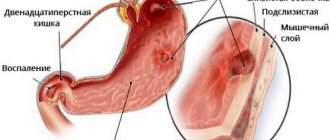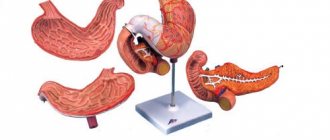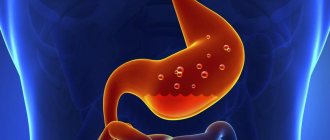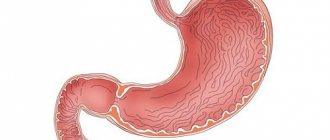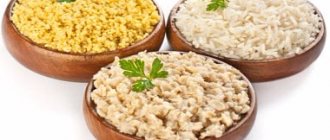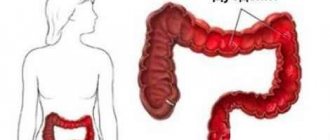- Gastritis symptoms ›
- Erosive gastritis ›
- Gastroenteritis
Gastritis symptoms , sometimes similar to symptoms of other diseases of the digestive system. Often gives no obvious signs. Gastritis of the stomach is also called catarrh, another common name is inflammation of the stomach.
In medicine, there is a distinction between acute and chronic . They are equally dangerous in that they can lead to bleeding and extensive ulceration (stomach ulcer). Gastritis often occurs due to the action of chemicals or pathogenic bacteria.
Symptoms occur acutely, manifested by pain in the epigastric region, lightheadedness, sometimes vomiting of food eaten mixed with mucus, bile, and total asthenia. In case of complications, signs of decreased blood pressure are added, the patient experiences pale skin, palpitations, and sometimes body temperature increases.
Signs of gastritis of the stomach in a chronic form with high or normal acidity are constipation and heartburn after eating food with acidic contents. After eating, patients complain of a feeling of heaviness after eating.
If there are symptoms of gastritis with high acidity, then they talk about pain in the epigastric region of the abdomen, heartburn, and sometimes vomiting. Patients with high acidity of gastric juice suffer from night and hunger pains, which go away if the patient eats something.
For patients with low acidity, symptoms are expressed by nausea, especially in the morning.
An unpleasant taste in the mouth, decreased appetite, rumbling in the stomach, patients suffer from diarrhea or constipation. Patients often burp air.
The chronic course of the disease is an unpleasant taste in the mouth, nausea, fullness of the epigastric cavity, salivation, loss of appetite and weight loss and symptoms of general loss of strength and the development of anemia, dyspeptic disorders.
Signs of catarrhal gastritis of the stomach
Catarrhal (simple) is the most common. Its causes are excess in eating and drinking, individual intolerance to one or another type of food or medicine, poisoning. Also, catarrhal disease can be caused by an infection when eating stale food, or food poisoning.
After the irritant ceases, the mucous membrane is able to repair itself. Catarrhal disease appears within four or eight hours after exposure to a negative factor has occurred.
One of its symptoms can be called pain in the stomach, a feeling of oversaturation of the stomach accompanied by nausea and vomiting, possible disorder of the entire digestive tract and progression and complications, a slight increase in temperature to 37 - 38 degrees. This may include dizziness, weakness and poor health of the patient in general.
Video: What is gastritis, gastritis symptoms, gastritis diet, stomach ulcers, how to treat gastritis
Corrosive (erosive)
Corrosive (erosive) - this type is associated with the impact of aggressive liquids such as acids and alkalis on the stomach, causing burns (chemical burns of the mucous membrane). Peptic ulcer disease is not a rare complication of erosive gastritis, since it is not the superficial layers of the mucous walls that are affected, but the deeper ones, with the formation of scars on the stomach.
Symptoms
It is impossible to diagnose gastritis in yourself, but you can notice that something is clearly wrong with your stomach. Symptoms of stomach inflammation in adults include:
- Heaviness in the upper abdomen (after eating);
- Nausea on an empty stomach or after eating;
- Constant drowsiness and weakness;
- Lack of appetite – weight loss;
- White coating on the tongue (often with a gray tint), excessive salivation, or vice versa – dry mouth;
- Fast saturation;
- Daily bloating.
The appearance of signs of gastritis depends on the form and causes of the disease.
People with a chronic diagnosis of increased (normal) secretion experience periodic pain in the stomach and heartburn.
Possible problems with stool, sourish-bitter belching.
Patients with chronic gastritis with low acidity usually complain of severe nausea in the morning, a strange taste in the mouth, frequent and loud rumbling in the lower abdomen, and indigestion (constipation or diarrhea).
Provoking factors
- Neglect of diet. Absorbing food “on the go” or “dry food” has a bad effect on the stomach.
- Too hot or cold dishes damage the mucous membrane of the organ. These “irritants” include savory dishes and hot seasonings.
- Excessive passion for strong coffee, tea or alcohol. Drinks, even in small quantities, are not good for the body. If you often consume them on an empty stomach, the risk of gastritis increases significantly.
- Another bad habit, addiction to tobacco, also reduces the performance of the stomach and digestive system.
- In 90% of cases, health problems in adults are observed after infection with bacteria - Helicobacter pylori. Until recently, nothing was known about the existence of the microbe, but the discovery of the bacterium by Australian scientists in 1981 was a revolution in the world of medicine. Treatment and prevention of the disease have improved significantly.
- A rare, but still possible cause of gastritis in adults is a malfunction of the immune system. It begins to fight the living cells of the body, rejecting the mucous layer of the organ, which leads to its disease.
- Taking medications that cause irritation of the mucous membrane.
- Hereditary predisposition to diseases of the digestive tract.
Functions of the stomach
First, let's touch a little on the question of how the stomach works and what its main functions are. The stomach is one of the most important organs of the human digestive system, where the process of digesting food begins. Here are the main functions of the stomach:
- ingestion of food coming from the esophagus;
- secretion of gastric juice intended for the primary breakdown of food mass;
- mechanical processing of food mass due to the reduction of walls;
- absorption of some substances necessary for the body;
- transfer of processed food mass to the small intestine.
All these functions are assigned to the walls of the stomach. They have a muscle base and can stretch widely if there is enough food. However, the functions of producing gastric juice are assigned to the inner layer of the walls - their mucous membrane.
Gastric juice contains components such as pepsin, gastrin and lipase, but the most important component is hydrochloric acid. It is well known from the chemistry course that this acid is one of the strongest. However, the walls of the stomach are designed so that they are not corroded by hydrochloric acid. Most of the acid is released in the upper part of the stomach - the body of the stomach. Closer to the duodenum, which is part of the small intestine, the stomach environment is neutral.
Under some circumstances, however, the mucous membrane ceases to perform its functions fully or becomes inflamed. A similar disease is called gastritis. Up to 50% of people in developed countries suffer from gastritis in one form or another. 80% of all diseases of the gastrointestinal tract are gastritis. In most cases, patients are adults, but it is now not uncommon for this disease to affect children.
How to treat
If you suspect a disease, you must first undergo examination by a gastroenterologist to confirm the diagnosis, determine the type and causes of its occurrence.
Treatment of the stomach is aimed at eliminating factors that irritate the mucous membrane of the organ, including taking medications and following a diet.
For patients with hyperacid gastritis (high acidity), the appearance of which is not associated with bacteria, exclude hot spices, smoked foods, fried foods, and marinades from your diet.
Among medical drugs, almagel and phosphalugel, which have enveloping properties, are effective.
Low acidity in the stomach with gastritis is treated by prescribing agents that enhance the effect of hydrochloric acid (abomine, pantoglucide, sodium chloride mineral water).
The menu of an adult with this type of gastritis should be rich in soups, fermented milk products (ryazhenka, low-fat cottage cheese), and vegetables.
Regardless of the form of gastritis, for a complete recovery, all patients must partially stop drinking alcoholic beverages, strong tea and coffee, reduce the number of cigarettes smoked or give them up altogether.
It must be said that inflammation of the stomach is not dangerous. If symptoms of gastritis are identified and treatment is prescribed on time, the inflammatory process is stopped quickly.
In some cases (when patients engage in improper self-medication and constantly put off visiting a doctor), complications are possible - bleeding from the stomach or an ulcer.
It is difficult to guess on your own about the presence of another disease, since the signs of gastritis and ulcers are not easy for an unqualified specialist to distinguish from each other.
Diagnostics
The doctor makes a diagnosis of gastritis based on all the patient’s complaints with the obligatory performance of gastroscopy. Treatment is prescribed according to gastroscopy data, the doctor can identify all the nuances: swelling, degree of redness, atrophy, the presence of erosions and the extent of the process, whether the entire stomach is affected or inflammation of only its individual part or areas.
There is a set of diagnostic measures, and the simplest and most common is a general blood test (deviation from the norm of such blood cell indicators as: leukocytes, platelets, ESR). In general, blood tests often show symptoms of anemia (megaloblastic) with a lack of vitamin B12 in patients with autoimmune gastritis. Anemia – macrocytosis of erythrocytes with Jolly and Cabot bodies. Your doctor may also order an occult blood test.
A biochemical blood test will also help in making a diagnosis. In a biochemical blood test, they look at the levels of protein in the blood and protein fractions, the levels of serum vitamin B12 and filic acid, and the determination of digestive enzymes.
When diagnosing a stomach ulcer, do the following:
- General urine analysis;
- Tests for the determination of H. pylori;
- Cytological examination of a biopsy of the mucous membrane;
- Histological analysis of the mucous membrane.
X-rays are not currently taken, and are used only during diagnosis, for diseases such as stomach cancer and peptic ulcers. Clinically, the signs of gastritis and these diseases are similar, and the patient’s condition does not make it possible to do a gastroscopy: old age, accompanying severe heart disease, lung disease, etc. The effectiveness of x-rays at the present stage is of course low. The acid test method using tablets is not very informative for a doctor.
The most effective method in making a diagnosis can be called esophagogastroduodenoscopy, biopsy and brush cytological analysis. Detection of pylori bacteria by biopsy of the mucous membrane, locally from the most altered areas of the stomach.
For diagnosis, the doctor prescribes gastroscopy.
+
Gastroscopy allows you to detect swelling of the mucous membrane, microbleeding, and erosion. To exclude symptoms of gastritis similar to acute myocardial infarction, the sick person is given an electrocardiogram; in this case, the pain may not be in the area of the heart, but in the pit of the stomach. During probing, the stomach and its secretory function are studied, and the pH of the patient’s gastric juice is measured.
Symptoms of gastric inflammation and ulcers
- Reducing food portions or completely eliminating food cravings;
- Belching of air or food eaten;
- Severe painful cramps in the stomach;
- Frequent heartburn.
Gastritis can turn into an ulcer due to lack of sleep, overwork, irregular nutrition, bad habits.
Despite the dissimilarity of the symptoms of gastritis and ulcers, the second problem is more pronounced.
With stomach and duodenal ulcers, pain occurs at night or when you feel hungry. There may be vomiting with scarlet blood clots.
The course of treatment and diet for patients with stomach ulcers is the same as for gastritis. Often, restoration of the mucous membrane of the organ and the functioning of the digestive tract is carried out in a comprehensive manner.
Taking medications is mandatory.
Treatment
Methods for treating ulcers and gastritis using traditional medicine:
- Drink a decoction of yarrow and buckthorn on an empty stomach once a day. For a liter of boiling water, take a tablespoon (tablespoon) of herbs, leave for at least 2 hours, and then filter the decoction. The drink restores the mucous layer of the stomach and improves the digestion process in the intestines.
- Thyme tincture. Taking 2 teaspoons of tincture daily before meals helps complete recovery of a person suffering from chronic gastritis. Take 2 tablespoons of dried thyme and place it in a saucepan or glass bottle (using plastic containers is not advisable). Then fill the herb with white wine (you will need about 500 ml), cover with a lid and put it in the refrigerator for a week. The resulting mixture must be boiled and strained through a gauze bandage.
Stomach ulcers and gastritis can be cured with potato juice, licorice root or sea buckthorn, ground with honey.
Classification
Depending on the course of the disease, cause, intensity and clinical manifestations, gastritis is divided into several forms:
- Depending on the reason:
- Primary – occurs as a result of injury to the mucous membrane by external factors;
- Secondary – occurs as a result of various diseases.
- Depending on the duration of exposure of these factors to the stomach, there are 2 forms of gastritis: acute and chronic.
Acute gastritis occurs due to the negative influence of various exogenous factors and is accompanied by signs of an inflammatory process. Depending on the degree of damage to the gastric mucosa:
- Fibrinous gastritis. This type of acute gastritis is characterized by the formation of a protein film on the gastric mucosa, which leads to the death of gastric cells. Its occurrence is rare, because it occurs in the presence of infectious diseases such as typhoid fever and smallpox.
- Catarrhal or alimentary. Only the top layer of the mucosa is injured. The cause of development will be parasites, poor-quality products, toxic substances, stress and emotional distress.
- Phlegmonous. It is almost impossible to encounter this type of gastritis; it is considered the most dangerous and leads to the development of deaths. It is characterized by a purulent inflammatory process of the walls of the stomach. Caused by infections and parasites.
- Corrosive. The occurrence of this form of gastritis is preceded by poisoning with heavy metals or toxic substances. Damage to the mucous membranes often leads to necrosis. It is characterized by a severe course, toxic substances enter the blood circulation and cause poisoning of the entire body. Complications such as peritonitis or renal failure may develop.
Chronic gastritis occurs as a result of long-term toxic effects of external and internal factors. As a result, structural changes occur in the gastric mucosa, which can subsequently lead to the development of atrophic processes.
Forms of chronic gastritis:
- Surface. The surface epithelium of the stomach is damaged.
- Atrophic. It is characterized by damage to the gastric mucosa of an atrophic nature. Considered to be a contributing factor to the development of cancer.
- Hypertrophic polyadenomatous. This form leads to the development of severe structural disorders, which lead to the formation of cysts and adenomas.
- Polypous. The disease leads to the formation of neoplasms - polyps.
- Bacterial. It develops as a result of the penetration of various infections into the body.
- Granulomatous. Occurs along with diseases such as sarcoidosis, tuberculosis and Crohn's disease.
- Autoimmune. Characterized by the appearance of atrophic inflammatory processes. Occurs against the background of autoimmune disorders.
- Alcoholic. Appears as a result of long and excessive consumption of alcoholic beverages.
You need to see a doctor. He will prescribe the necessary diagnostic measures and adequate treatment.
Types of gastritis
There are basically 2 main types of the disease. First, a person develops an acute form, manifested by sharp pain in the stomach, heaviness after eating, nausea and vomiting, alternating constipation or diarrhea, heartburn, and general weakness.
An attack may first begin after exposure to an irritant: spicy food, coffee, alcohol or long-term drug therapy. If you don’t immediately determine the presence of pathology and start treatment, but let everything go, in 85% of cases it will become chronic.
The chronic course of the disease is characterized by alternating periods of exacerbation and remission . As before, a person is bothered by pain in the stomach, nausea after eating, frequent belching, constipation alternating with diarrhea, and flatulence. But all these are only general signs that are characteristic of all forms of the disease.
Gastroenterologists distinguish several types of processes occurring in the stomach, which have individual manifestations, but are united by the name gastritis.
What forms of acute manifestation of the disease can be distinguished:
- simple;
- phlegmonous;
- toxicochemical;
- fibrinous.
Another article on this topic: Why no appetite? How to increase appetite in an adult?
The chronic form is also divided into several types:
- associated - caused by Helicobacter pylari;
- autoimmune - developing due to the formation of antibodies to gastric cells;
- chemical - caused by long-term use of NSAIDs or developed as a result of constant bile reflux;
- idiopathic - arising due to regular exposure of the stomach to any aggressive factor;
- granulomatous occurring simultaneously with inflammation elsewhere - tuberculosis, sarcoidosis.
Gastritis must be taken very seriously, since the chronic form sooner or later develops into a stomach ulcer, and an ulcer is considered a precancerous disease.
Complications and consequences
Dangerous complications:
- Internal bleeding. Due to the gradual destruction of the gastric mucosa, blood begins to penetrate through the walls. This complication is considered fatal and therefore there is no time to delay; you must quickly call an ambulance.
- Peritonitis and blood poisoning. Due to untimely seeking of help, the infection penetrates through the abdominal cavity into the bloodstream. As a result, we have infection of the entire body. When performing surgery, there remains a risk of death.
- Stomach cancer. Research has proven that almost every tenth case of malignant neoplasms occurs as a result of gastroenterological diseases. And if the tumor is not diagnosed in a timely manner, the patient will face a slow and painful death. This type of complication is observed with gastritis, which occurs as a result of infection by Helicobacter pylori. Persons with bad habits are prone to the occurrence of malignant neoplasms, but those individuals who like to eat spicy and smoked foods are no exception.
- Anemia. As a result of the presence of diseases that affect the digestive tract, vitamin B12 loses the ability to be absorbed. The result is a lack of iron, which develops into iron deficiency anemia.
- Pancreatitis. Due to untreated and neglected gastritis, the inflammatory process spreads to the pancreas. People with gastritis who drink alcohol and smoke in large quantities are at risk of getting pancreatitis. People taking antibacterial drugs are at risk.
- Stomach ulcer. Due to the bad effect of acute or chronic gastritis on the gastric mucosa and untimely treatment, an ulcer is formed.
Diagnostic examination
To correctly establish a diagnosis, it is necessary to carry out certain diagnostic tests.
To determine it, the following are used:
- gastroscopy – using a special apparatus, the mucous membrane of the organ is examined;
- study of gastric secretions in a laboratory;
- blood and stool tests;
- biopsy of the mucous membrane of the digestive organ.
First of all, when conducting a diagnosis, a specialist aims to establish the cause that led to the development of the disease. Treatment depends on this.

